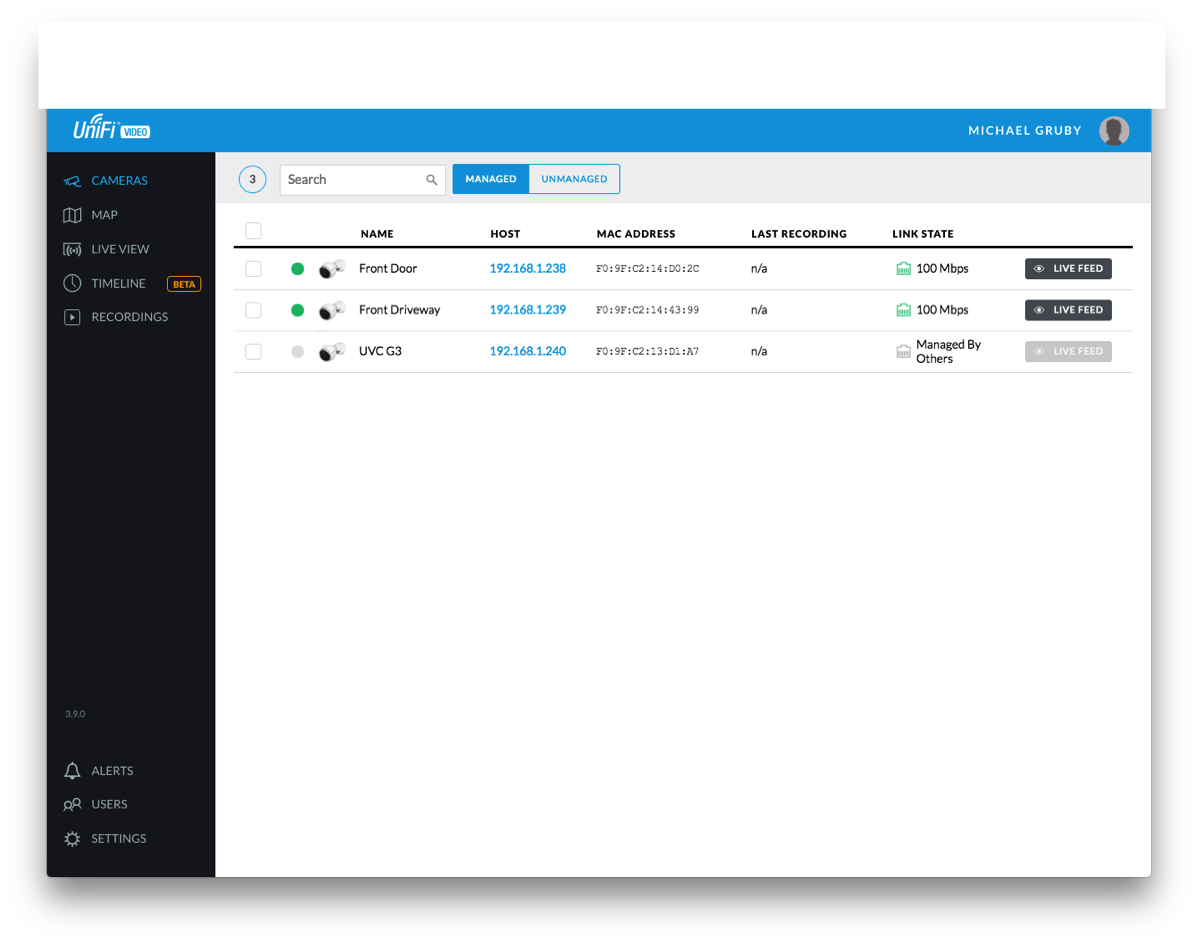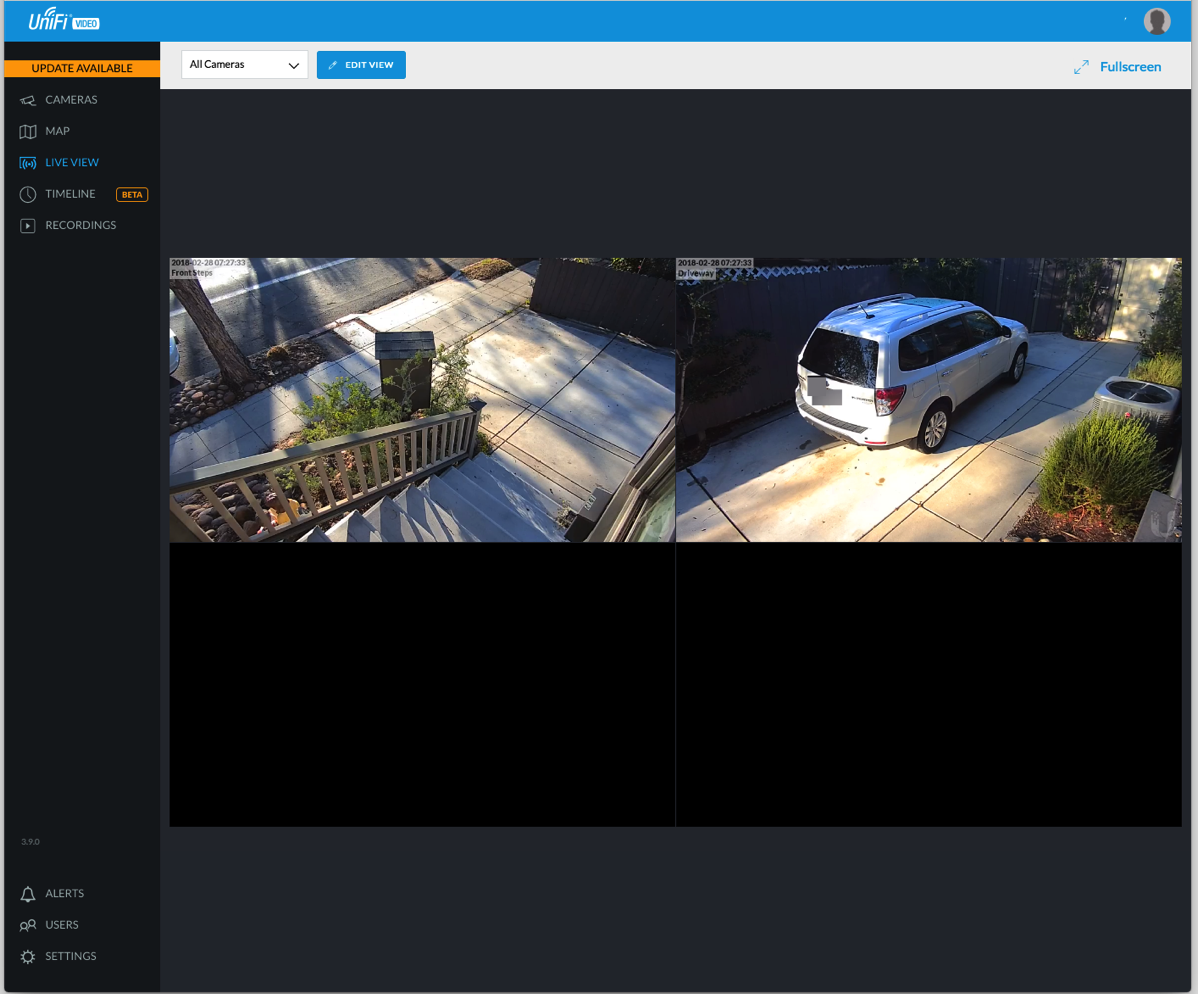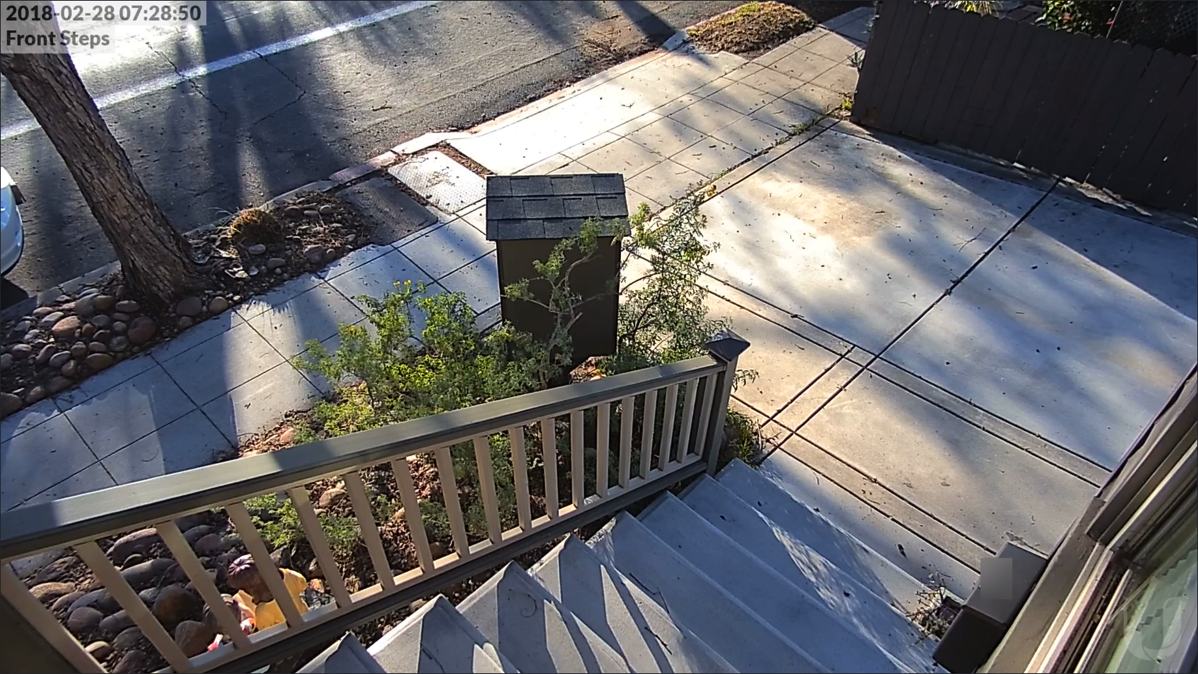[Updated 2/28: Added camera images]
As anyone that reads my blog can tell, I really like Ubiquiti networking gear. When I saw that they also had a video/NVR platform, I really wanted to try it. However, since I already had a working surveillance system, I couldn’t justify the cost to convert. Recently my father wanted a recommendation on a surveillance system and I started looking at options. There were a few complete systems at Costco, but they all received pretty mixed to poor reviews. I could point him to Nest cameras or a similar system, but each system was cloud based with a yearly fee. In addition, the cost of the cameras was a bit on the high side. With the Costco systems, I was concerned about ease of use and security of the cameras; many of the Chinese made/designed cameras have major security flaws that keep getting exposed. Securing these systems would take a lot of work and they would likely never receive firmware upgrades.
Once I added up the cost of 4 Ubiquiti UVC-G3 Cameras and a UVC-NVR
, the Ubiquiti solution didn’t cost much more. The solution would have cost more, but I had a spare 8-Port UniF Switch (US-8-150W)
sitting around that I gave my dad. My dad was onboard and he ordered all the components and some patch cords. We decided using 25 ft and 50 ft patch cords was easier than running structured wiring, so all we had to do was mount the cameras and string the patch cords in the attic.
I left most of the physical install to my dad and brother-in-law. Running the wires is never a straightforward task, but we got it done after a number of hours of work. We mounted the cameras so that they could be seen as I think it is a valuable deterrent.


While my dad doesn’t have an equipment rack like I do, his collection of equipment keeps gettin bigger!

While the physical install was in process, I started the software setup and install. The initial setup was pretty straight forward. I hard reset the UniFi switch (it had my config on it) and adopted it. Then I set the switch to do 24V passive PoE (it is a UniFi switch) so that I didn’t have to use PoE adapters. Plugging in the NVR was easy and it started up without problems.
The NVR setup wizard had me setup a Ubiquiti account for my dad and then it locally discovered the NVR (using Chrome). I probably should have read the instructions, but I didn’t and had a little trouble with this. I thought that creating the Ubiquiti account would go through a process to adopt the local NVR; it really didn’t and I had to connect the NVR to my dad’s Ubiquiti account later.
Once I was able to access the NVR, it should have been a simple process to plug in each camera and adopt it. Unfortunately I didn’t read that I had to use ubnt/ubnt as the username and password. I simply left it blank and got no where. After a few resets of the camera and a web search, I properly entered the username and password and the cameras adopted without problems.





After the software setup, I installed the iOS app, connected my Ubiquiti account (for testing I added a user for me) and was able to use the app to help adjust the cameras. The app needs work, but it is usable. As WiFi coverage on the outside of the house was spotty, the image kept freezing until I realized that I should just turn off WiFi and let the image stream over cellular.
Once we completed the install, I turned over the “keys” to my dad and let him configure the recording, motion detection, etc. I only gave him a basic overview as the software is pretty self explanatory which is great.
With the install completed, I decided to use the last camera for my own system and setup the UniFi video software on an Ubuntu virtual machine. The install was pretty straightforward and I decided to store the recordings on a Shared Folder (VMWare). I had to add the following to /etc/fstab:
./host:/ /mnt/hgfs fuse.vmhgfs-fuse allow_other,defaults,uid=109,gid=117 0 0
Where 109 and 117 are the uid and gid respectively of the unifi-video user. I also followed the instructions for installing a custom SSL certificate. I had some problems initially setting up the software as the UniFi Discovery Tool wouldn’t locate it, but after I connected directly to it instead of using https://video.ubnt.com, I was able to get it working. Will I keep it running? I still haven’t decided.
Pros
- Unified interface for camera management including being able to change white balance, contrast, etc. on each camera.
- Regular updates of the camera firmware and recording software.
- A company concerned about security.
- Free remote viewing system.
- iOS app.
- Decent video quality.
- NVR is compact.
Cons
- Remote browser viewing seems to require/prefer Chrome.
- If you don’t already have a PoE switch, there is an extra cost involved. The 5 pack of cameras doesn’t come with PoE injectors. The PoE injectors are unwieldy if you have more than one camera as each requires an outlet.
- Some discussion in the forums about quality of the iOS software.
- Timeline won’t show multiple recordings at once.
- Timeline feature needs some work.
Now that I have my dad’s whole system setup, I have to decide if it is worth replacing my 7 cameras with the UVC-G3 cameras. Since I already have a switch to power them and I’d run the software on a virtual machine, my cost is under $900. That’s a lot of money to spend when I have something that already works. I would get a better interface, easier remote viewing (right now I VPN into my home network to view the cameras), better video quality (my cameras are 720p), less concern over security issues in the cameras as Ubiquiti regularly updates the firmware and the recording software, and unified management of all the cameras (if I want to change the brightness or contrast on a camera, I have to connect directly to that camera and change the setting). However, the software I use now has a better timeline feature.
I’ll probably wait until something breaks before doing something; my system has been running (different hardware and software versions, but same cameras) for almost 5 years without a hiccup.
If you’re shopping for an NVR/camera setup, the Ubiquiti offering is interesting, but I think it needs a little work around the timeline feature and the iOS app before I can completely recommend it. While I don’t have much experience with other systems, this system takes a little technical know how as the switch has to be configured and the cameras adopted. For an installer to install this, I think it would be fine; for the average consumer I’d look elsewhere at least for now.
Great timing, Scott. I’m about to pull the trigger on getting about 8 G3’s. I’ve already got the POE switch (planned that when I got it for the rest of the network and got the edgeswich 16 port POE.)
I was planning on using my NAS (Qnap) as my NVR, as it has an install of a surveillance monitoring/recording software called Surveillance Station. I’m not sure of the ability to push to an app on my phone however, which would be highly desireable.
Do you think with the current problems with the NVR it would be worth the price when I already have a capable system?
Hi Paul,
If you already have cameras, I don’t think getting the G3s is going to be a huge win. The G3s work best with the UniFi NVR. Having said that, the individual G3s can now stream RTSP so they can be used with almost any NVR. I don’t know anything about Surveillance Station, so I can’t comment on how good or bad it is compared with the UniFi NVR.
If you don’t already have cameras, the G3s appear to be decent cameras and receive firmware updates which is huge for me as I don’t have to worry about them being abandoned and potentially doing a DDOS attack like some cameras have done. With the RTSP support in the cameras, you can get the G3s and try out the UniFi NVR and then use something else if the NVR isn’t up to your needs.
If all my cameras broke tomorrow, I’d replace them with G3s and use the UniFi NVR even if it lacked some features as the convenience of unified management outweighs the negatives. If 1 or 2 cameras broke, then I’d replace them with G3s, but keep using my current solution of SecuritySpy running on my Mac Pro. I’d have to have 3 break at which time I’d go all in with the UniFi NVR (you can buy G3s in either a 1 or 5 pack and I currently have 7 cameras).
Hope that helps!
I do not have the cameras yet. But since I have an extensive array of UBNT products, and I’m a huge fan, it was an obvious choice. I’ve heard the less than stellar reviews of the NVR on the forums, and since I have a NAS with the capability (and ubiquiti support), I think what I will do is try that first since it’s essentially running already and wont require additional hardware. Qnap now has an app that will push all of the video, camera control, etc right to your IOS device.
I think that the G3 cameras are going to be a better bet than the Q-See and Dahua ones I have. Going with the cameras gives you lots of options as they can do RTSP as I mentioned.
Good luck!
I was running SecuritySpy on a dedicated Mac mini with a mishmash of cameras from Foscam and D-link.
It always felt a bit fragile, and image quality was pretty so-so, and after a good experience trialling UniFi networking gear I bit the bullet about a year ago and cabled the whole house for UniFi APs and cameras.
I now run 16 UniFi cameras – several G3 and G3 Domes, a Pro and three Micros – off a 2TB NVR.
The reason for my comment is that I still run SecuritySpy on my Mac mini, pointing to the RTSP stream of each camera made available by the NVR. It’s not the cheapest solution, but I have independent NVR control using two systems, including dual recording in two locations in very different areas of the house, and I’ve retained all the features of SecuritySpy that I like. An added bonus is that the UniFi NVR does the heavier lifting, which means I can now run a low spec late 2012 Mac mini with 8GB RAM for way more cameras than SS direct could handle on that hardware, and have my more powerful Mac mini server to use for other things.
The single downside besides cost (and that’s only really the cost of the NVR as everything else is required anyway) is that the NVR is a single point of failure, as I couldn’t get an RTSP feed direct from the cameras when they are in managed mode. I can live with that as it’s no worse than it would be if I only had the UniFi setup.
Anyway, although it’s 12 months on from your post I thought I’d share my setup as it might be something that would work for you, letting you run UniFi cameras but retain the features you like from, and your investment in, SecuritySpy.
I actually just ordered a G3 Flex to test, and if it is good I might up my SecuritySpy license to the next level (32 cameras) and add a few of those to fill in some of the areas where I still haven’t got maximum coverage.
Hi Fen,
Thanks for your comments! Luckily I don’t have to look at my cameras all that often and have only reviewed video once or twice in the last year. I like the UniFi Protect stuff, but I have no plans on investing in it at this time. Maybe when everything stops working, I’ll take another look!
I have a QNap and don’t really like Surveillance Station so it’s worth mentioning Unifi Video (and Unifi controller) apps are available as a 3rd party package from QNapClub.eu
Good to know that there are options; thanks!
Hi, are you actually using Unifi Video qpkg on your QNAP? I just got a G3 Flex camera and was unable to get it adopted by Unifi Video. I’m thinking it could be to do with different camera firmware vs unifi video versions.
I’m in pretty much the same boat as you, have a Ubiquiti network (with Cloud Key Gen2 Plus) and also a working-ish Chinese system with 5 cameras…last night ran a firmware upgrade that magically lost all settings and disabled all cameras…something I know would never happen with Ubiquit.
Now I’m facing the possibility of having to climb a ladder to reset each camera…I think I’d rather just replace each camera with Ubiquiti instead!
Good luck with your decision! My cameras haven’t gotten a firmware update in years and have been humming along which makes my decision quite easy; just leave them!
Scott,
It seems you are well versed with regard to the Ubiquiti suite of cameras so I will pose this question to you. I currently run an 8 port Ubiquiti POE switch with one AP. I ordered a Unifi G3 Dome camera for indoor use and upon plugging it in the latency is pretty bad on the live video feed. I do not have an NVR so I am running it standalone via the web based connection. Two things: is the latency normal? and I can’t seem to download the Unify Video software without getting error messages in the process. I am using Windows 10 and downloading the latest version at the Ubiquiti website. I was really hoping this would work out but so far it has been a disaster and you can’t get someone on the phone at Ubiquiti support for help. Can you give me some pointers on what I might be doing wrong? Thank you!
Hi Kael,
Unfortunately I haven’t touched the Ubiquiti cameras since I wrote that post. A friend of mine has been using a bunch of the cameras with the NVR and has been quite happy with them. I’d suggest just keep trying with Ubiquiti tech support and they will hopefully be able to help you.